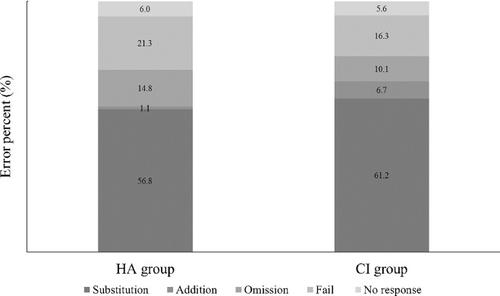当前位置:
X-MOL 学术
›
Auris Nasus Larynx
›
论文详情
Our official English website, www.x-mol.net, welcomes your feedback! (Note: you will need to create a separate account there.)
The error patterns of phonemes in children with prelingual hearing loss: A comparison between hearing aid and cochlear implant users
Auris Nasus Larynx ( IF 1.7 ) Pub Date : 2024-03-26 , DOI: 10.1016/j.anl.2024.01.001 Yuri Nishiyama , Shujiro Minami , Ryoko Ijuin , Tomoko Kuroki , Ayako Tendo , Yuko Kusui , Satoko Wakabayashi , Kimitaka Kaga
Auris Nasus Larynx ( IF 1.7 ) Pub Date : 2024-03-26 , DOI: 10.1016/j.anl.2024.01.001 Yuri Nishiyama , Shujiro Minami , Ryoko Ijuin , Tomoko Kuroki , Ayako Tendo , Yuko Kusui , Satoko Wakabayashi , Kimitaka Kaga

|
To reveal differences in error pattern of phonemes and articulation between children using cochlear implants (CIs) and those using hearing aids (HAs) due to prelingual hearing disorder and help the education of children with prelingual hearing loss. Children with prelingual hearing loss who were receiving auditory-verbal preschool education at an auditory center for hearing-impaired children (Fujimidai Auditory Center, Tokyo, Japan) from 2010 to 2020 were analyzed retrospectively. All participants underwent pure tone audiometry and monosyllabic intelligibility tests. The error answers were categorized into five patterns which was characterized by the substitution, addition, omission, failure, and no response according to consonant errors. In addition, the consonant errors classified into the manner of articulation and the differences of error patterns were analyzed between the HA and the CI group descriptively. A total of 43 children with bilateral HAs and 46 children with bimodal CIs or bilateral CIs were enrolled. No significant between-group differences in median phoneme intelligibility were found. The most common error pattern was substitution in both HA and CI groups. The error number of addition pattern in the HA group was smaller than in the CI group. In both groups, the most common errors of articulation were flap errors, and the most common error patterns were flaps to nasals, nasals to nasals, plosives to plosives. In the HA group, plosives and nasals tended not to be recognized and in the CI group plosives were prone to be added to vowels. There were some different error patterns of articulation and consonant substitution between groups. Clarifying differences of phoneme that are difficult to hear and tend to be misheard would help for creating an effective approach to auditory training for children with hearing loss.
中文翻译:

语前听力损失儿童的音素错误模式:助听器和人工耳蜗使用者的比较
揭示因语前听力障碍而使用人工耳蜗(CI)和使用助听器(HA)的儿童在音素和发音方面的错误模式的差异,有助于语前听力损失儿童的教育。对2010年至2020年在听障儿童听觉中心(日本东京藤见台听觉中心)接受学前听觉言语教育的语前听力损失儿童进行回顾性分析。所有参与者都接受了纯音听力测试和单音节清晰度测试。根据辅音错误将错误答案分为替换、添加、省略、失败、不响应五种模式。此外,对HA组和CI组之间按发音方式分类的辅音错误以及错误模式的差异进行了描述性分析。共有 43 名双侧 HA 儿童和 46 名双峰 CI 或双侧 CI 儿童入组。中位音素清晰度没有发现显着的组间差异。最常见的错误模式是 HA 和 CI 组中的替换。 HA组中添加模式的错误数小于CI组。在两组中,最常见的发音错误是瓣音错误,最常见的错误模式是瓣音到鼻音、鼻音到鼻音、爆破音到爆破音。在HA组中,爆破音和鼻音往往无法被识别,而在CI组中,爆破音很容易被添加到元音上。各组之间存在一些不同的发音和辅音替换错误模式。澄清难以听到和容易听错的音素差异将有助于为听力损失儿童创建有效的听力训练方法。
更新日期:2024-03-26
中文翻译:

语前听力损失儿童的音素错误模式:助听器和人工耳蜗使用者的比较
揭示因语前听力障碍而使用人工耳蜗(CI)和使用助听器(HA)的儿童在音素和发音方面的错误模式的差异,有助于语前听力损失儿童的教育。对2010年至2020年在听障儿童听觉中心(日本东京藤见台听觉中心)接受学前听觉言语教育的语前听力损失儿童进行回顾性分析。所有参与者都接受了纯音听力测试和单音节清晰度测试。根据辅音错误将错误答案分为替换、添加、省略、失败、不响应五种模式。此外,对HA组和CI组之间按发音方式分类的辅音错误以及错误模式的差异进行了描述性分析。共有 43 名双侧 HA 儿童和 46 名双峰 CI 或双侧 CI 儿童入组。中位音素清晰度没有发现显着的组间差异。最常见的错误模式是 HA 和 CI 组中的替换。 HA组中添加模式的错误数小于CI组。在两组中,最常见的发音错误是瓣音错误,最常见的错误模式是瓣音到鼻音、鼻音到鼻音、爆破音到爆破音。在HA组中,爆破音和鼻音往往无法被识别,而在CI组中,爆破音很容易被添加到元音上。各组之间存在一些不同的发音和辅音替换错误模式。澄清难以听到和容易听错的音素差异将有助于为听力损失儿童创建有效的听力训练方法。



























 京公网安备 11010802027423号
京公网安备 11010802027423号